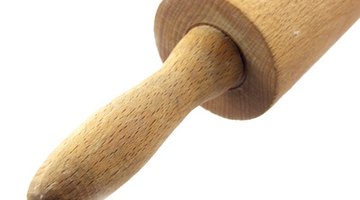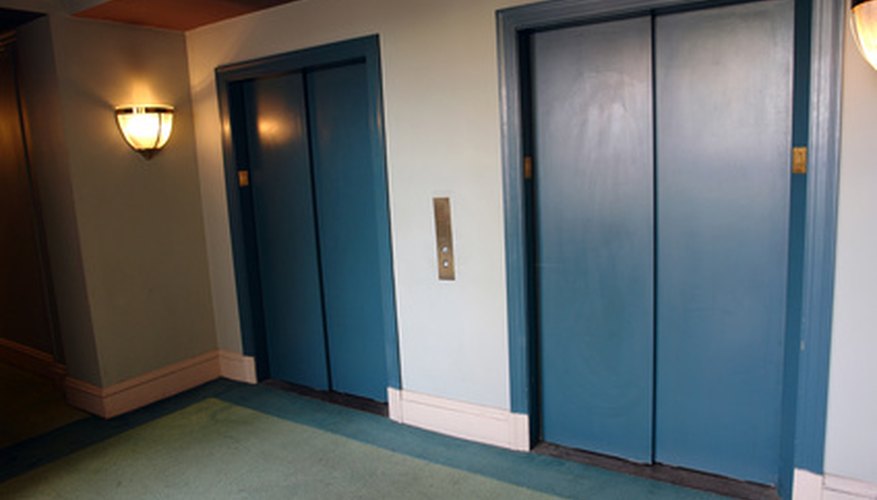In a larger application of linoleum flooring, inevitably sections of flooring must be joined.
To help hide the seams between sections of linoleum, create a pattern beforehand. A pattern is created on paper, and the linoleum panels are then cut to adhere to it. Lay out the pattern in such a way that the seams fall outside of high traffic areas. The natural variation in linoleum flooring helps to hide the seams, and most linoleum manufacturers recommend that the linoleum sections are butted tightly together.
- In a larger application of linoleum flooring, inevitably sections of flooring must be joined.
- To help hide the seams between sections of linoleum, create a pattern beforehand.
Start with the longest wall in the room you are flooring and lay out your kraft paper. Tape the sheets of kraft paper together with masking tape. Press the paper flat as you work your way across the room.
Work your way across the room and where the pattern meets the far wall, cut the paper with a sharp utility knife. Consult the manufacturer's instructions, and leave an expansion joint where the paper meets the wall if recommended.
- Work your way across the room and where the pattern meets the far wall, cut the paper with a sharp utility knife.
- Consult the manufacturer's instructions, and leave an expansion joint where the paper meets the wall if recommended.
Use your utility knife to cut the paper where it runs into obstacles. Leave the recommended expansion gap. Take great care when working around obstacles to ensure accuracy.
Mark the upper side of the pattern with a felt tip pen. Write the word "TOP" on the upper side of the paper to avoid confusion after the pattern is rolled and then moved to the location where you will lay out and cut your linoleum.
Once the pattern is created, carefully roll the paper up and take it to a spacious location where you can lay out and cut your linoleum.
Lay your linoleum out face up in a large room, such as a living room or a garage floor. Mimic the layout of the room you will be flooring. Lay out the linoleum so that seams are running perpendicular to entryways. Avoid positioning the seams in high traffic areas if possible.
- Once the pattern is created, carefully roll the paper up and take it to a spacious location where you can lay out and cut your linoleum.
- Lay out the linoleum so that seams are running perpendicular to entryways.
Overlap the seams between sheets of linoleum by at least one inch. Note the pattern of the linoleum. Align the seams to complete a recurring pattern, or utilise the variation in the product to help hide the seams.
Use a utility knife and a straight edge to cut the overlapped linoleum along the seams. Remove the excess material, then tape the two pieces of linoleum together with masking tape.
Unroll your pattern and lay it over the top of your linoleum. Use your utility knife and straight edge to conform the laid out and taped linoleum to the pattern.
Roll up the pattern and set it aside. Then roll up the cut and taped linoleum and bring it to the area where you will be installing it.
- Use a utility knife and a straight edge to cut the overlapped linoleum along the seams.
- Then roll up the cut and taped linoleum and bring it to the area where you will be installing it.
Sweep and vacuum the subfloor. Make sure the surface is level and completely free of dirt or debris.
Unroll the linoleum. Inspect the linoleum and make sure it fits precisely around the perimeter of the room. Use your utility knife to trim away any excess material.
- Inspect the linoleum and make sure it fits precisely around the perimeter of the room.
Start with the largest piece of linoleum. Anchor half of the sheet by weighing it down with a heavy object, such as a tool box or several cans of paint. Make sure the linoleum sheet is anchored securely so that it will not shift while you unroll the free half and apply adhesive to the floor. Remove the masking tape from the seams.
Roll back the free half of your first sheet of linoleum. Apply your linoleum adhesive to the subfloor according to the adhesive manufacturer's instructions. Lay the linoleum down in the adhesive. Press the linoleum down firmly. Start at the centre of the sheet and work your way out to the edges.
- Roll back the free half of your first sheet of linoleum.
Roll back the second half of your first piece of linoleum. If there is a seam, use a pencil to mark the seam line on the floor. Then roll back the second piece of linoleum to provide access to the subfloor.
Apply adhesive to the floor, including beyond the seam line. Press the linoleum down into the adhesive.

Continue this process of gluing down each sheet of linoleum. Run a roller along the seams to ensure the linoleum is pressed flat. After the entire floor has been adhered, roll the entire floor to squeeze out air bubbles and ensure a tight seal.
